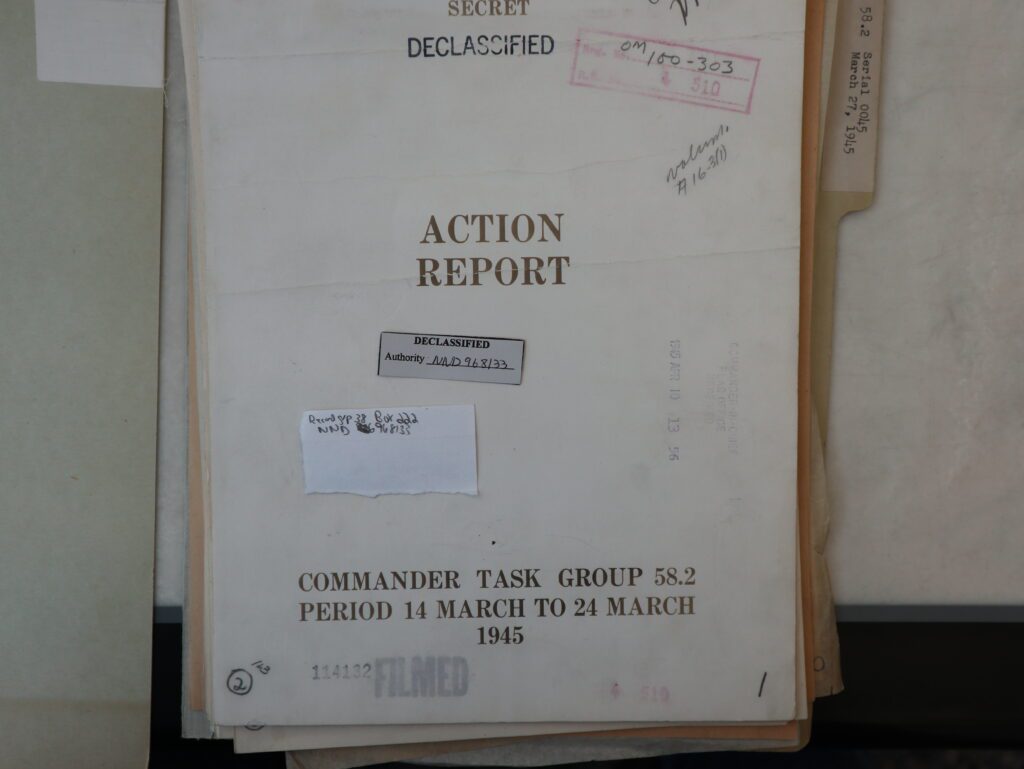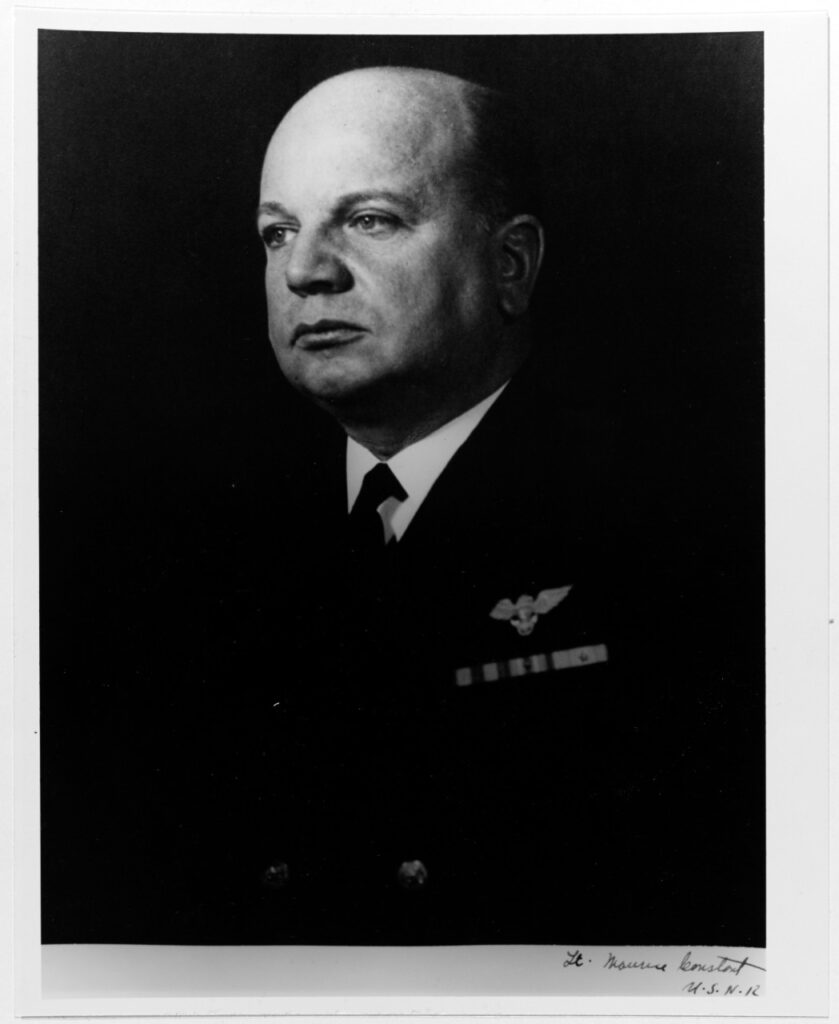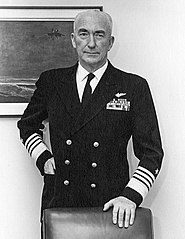Highlights From “ACTION REPORT: TASK GROUP 58.2

I’ve been studying the Task Group 58.2 Action Report that covered Task Force 58’s March 1945 mission to suppress and destroy Japanese air and naval assets before the invasion of Okinawa.
During this mission, USS Franklin was attacked and severely damaged by a Japanese bomber. The Admiral commanding the task group, Ralph Davison, flew his flag from Franklin. His Chief of Staff, Captain James Russell, had played a key role in designing Essex-class carriers’ aviation components before we entered the war. After the war started, Russell commanded a PBY squadron in the Aleutians, serving under Leslie Gehres, then a Commodore, before he became Franklin’s captain. The Admiral and Captain Russell were present during the 30 October 1944 kamikaze and 19 March 1945 attacks.
While Admiral Davison would sign the report, Captain Russell was ultimately responsible for drafting it.* The report covers the entire mission, not just when Franklin was present. Because of the severity of the damage to her, it goes into great detail and makes many recommendations.
The report reflected the US Navy’s culture of brevity and emphasis on facts. The tone of the entire report is professional, and I would expect nothing less to bear an admiral’s signature.

Action Report Highlights
This report was divided into eight parts, starting with Part I, which summarizes the events. Other parts include:
- A chronological account.
- Damage done to the enemy.
- Damage suffered by enemy attack.
Today, I will focus on Part VII, Personnel Performance, and three recommendations from Part VIII, Lessons Learned, Conclusions, and Recommendations.
Here is the entirety of Part VII referring to the men serving on 26 ships in Task Group 58.2:
The performance of personnel was excellent. In the presence of many operational and tactical changes necessitated by exigencies of the action, personnel efficiency was maintained at an exceptionally high level. In the presence of particularly severe damage and casualties suffered from enemy air attacks, men and officers met their responsibilities to the ships and survivors in a manner consonant with the high traditions of the United States Naval Service.[i]
If anything, the above is understated. Other ships, including carriers, were damaged, and many ships rendered aid.
Two Things Can Both Be True

I have no doubt that Part VII accurately reflects Admiral Davison’s and his staff’s views. I also have no doubt that Captain James Russell had little respect for Captain Leslie Gehres. (More about that here.) When the report was written, Gehres was already vocal about some officers and enlisted men disobeying his orders by leaving the ship without permission. Whether or not Part VII’s last sentence was directed at Captain Gehres, he certainly would not have liked it if he had read it.
Davison, Russell, and the surviving flag staff left the ship on the morning of 19 March, several hours after the attack. In a 1976 oral history, he told his interviewer, John T. Mason, Jr., that he went on board Franklin after she returned to Ulithi days later.
Russell: Everyone who came aboard went before a reception committee. The skipper was determined he’d take nobody from his crew back aboard who’d gone over the side, which I thought was a little bit unnecessary.
Mason: Enveloped in flames, should they stay aboard?
Russell: And get burned to death! Should think they’d hit the sea! But he was intent on taking only those who remained aboard.[ii]

PART VIII – LESSONS LEARNED, CONCLUSIONS, AND RECOMMENDATIONS
This section contains eight recommendations. I will touch on three of them.
The Ship’s Readiness
The first recommendation discusses the material status Franklin was in when she was attacked. The report states:
At the time of attack the ship was not in complete material condition of readiness for action. From this there is one obvious lesson, namely that whenever operations in an area where attack from enemy aircraft is likely, or when bogies have been reported, ships must maintain the highest material security possible, and the lookouts and gun crews must maintain the highest degree of vigilance and alertness. This should be done even at the sacrifice of a hot meal or two, or other personal discomforts. From observation of the variety of conditions of readiness existing among several carriers it is recommended that efforts be made to make standard which hatches to vital parts of the ship should be opened or closed during condition “One-Easy.” [iii]
I looked at six different books written about Franklin, her captain, or her Catholic chaplain. None of them agree about why Captain Gehres eased the ship’s readiness. One fails to mention it at all, and another is flat wrong (no, the Admiral cannot order a change in the ship’s readiness; that’s the province of the captain).
Several sources agree that Admiral Davison recommended to his ships that they stand down from the highest readiness. (I’ll do more research on this.) However, if true, Captain Gehres didn’t choose to go that far. He did lower the readiness to Condition III, which is what some have said the Admiral recommended, but according to the Deck Log Remarks Sheet for that day, at
0611 set condition III except in batteries and fire control stations.
In Joseph Springer’s book, Inferno: The Epic Life and Death Struggle of the USS Franklin in World War II, several crew members state that gun crews could send one or two men to get food.
Here’s what I find interesting. The report recommends maintaining conditions at a higher level in similar circumstances. Nowhere does it mention that the Admiral suggested that readiness be eased.
I’ve met many family members of the crew. A common question is, “Why didn’t the captain call the ship to General Quarters when USS Hancock spotted the first bogie (unknown contact)? The report does not directly address this question.
Franklin’s Turn To Starboard
Describing the ship’s turn to starboard as fires and explosions were ravaging it, The report states:
The initial turn of Franklin to starboard and her continuing the turn to bring the wind on the port quarter is a maneuver which is not recommended. It smoked out the top side firefighting parties, seriously impaired the efficiency of the ship’s control personnel and put tremendous quantities of black smoke into the ventilating system particularly of the boiler and engine rooms.
Admiral Davison and Captain Russell were eyewitnesses on the flag bridge overlooking the flight deck.
Franklin was Captain Gehres’s first command at sea since he had become a naval aviator. He was knocked to the deck when the attack happened. It took 15 minutes for him to recover, as he had evidently inhaled a great deal of smoke.[iv] During that time, the next senior officer on the bridge was the ship’s navigator, Stephen Jurika. This was the first time Jurika had been at sea in several years and his first time in a senior position.
Accounts are vague about who ordered the turn to starboard (Russell calls this “a doctrine turn to starboard “and assumes it was the captain). Russell then reports that Admiral Davison asked him to “present his compliments” to the skipper and “suggest that he put his ship into the wind so that he can get his fires under control.” [v] By the time Russell reached the captain, Gehres was in command again.
“Gallery Deck Compartments on FRANKLIN Proved A Trap For Personnel” [vi]
The best way to describe the gallery deck is to say that it was hung overhead on either side of the hangar deck just below the flight deck. In addition to multiple bomb and rocket explosions on the hangar deck, there was at least one massive fuel oil explosion. Hundreds died on the hangar and gallery decks. The report states that no one survived inside the gallery deck’s Combat Information Center (CIC) located on the gallery deck. Many of the pilot ready rooms were also located on the gallery deck resulting in the deaths of many aircrews who were waiting to man their planes. After the war, the gallery deck would be eliminated, and the CIC and pilot ready-rooms relocated.
I found the report fascinating, and I look forward to comparing it to other ships’ war diaries, logs, and cruise books.
*When quoting directly from the Action Report I have chosen not to correct grammar or to use the term [sic].
Did you arrive here via a search engine? I am the author of the forthcoming book Heroes By The Hundreds: The Story of the USS Franklin (CV-13). In addition to writing about the bravery of the crews that saved her, I will discuss the lessons we can learn in leadership and decision-making and the changes the US Navy made because of those lessons.
Feel free to follow me on Facebook. There, I am M. Glenn Ross, Author. I also write a monthly newsletter, Glenn’s After-Action Report, about subjects I find interesting in my research. You can sign up for it below. Feel free to leave a comment or ask a question. Thanks for reading.
-Glenn
[i] Action Report: Commander Task Group 58.2 Period 14 March to 24 March 1945, US National Archives Record Group 38 Box 222 Part VII p 32
[ii] Russell, Admiral James S., The Reminiscences of Admiral James S. Russell, USN (Ret.) Interviewed by John T. Mason, Jr. 1976, US Naval Institute: Annapolis 224
[iii] Action Report Part VIII p 33
[iv] Jurika, Capt. Stephen, _The Reminiscences of Capt. Stephen Jurika, Jr., USN (Ret.), Vol. II_, Interview by John T. Mason, Jr. 1979, US Naval Institute: Annapolis 635
[v] Russell 217
[vi] Action Report Part VIII p 34